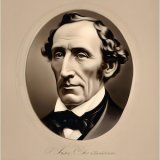The Beetle Who Went on His Travels Page #2
"The Beetle Who Went on His Travels" is a captivating children's book by famed author Hans Christian Andersen. The story centers around an adventurous young beetle who doesn't want to settle for his mundane life under a fern. Despite warnings from his elders, he sets off to see the world. The beetle undertakes an enchanting and life-changing journey encountering many interesting characters and experiences. His travels challenges his worldview and eventually teaches him the true meaning of home and happiness. The book is adorned with timeless lessons about self-discovery, adventure, and the charm of the simple life.
Genre: Children
Genre: Children
- 23 Views
mother, is it not Mr. Beetle?" for she knew the stranger by his horny coat. "You are both quite right," said he; so they begged him to walk in, that is to come as far as he could under the broken piece of earthenware. "Now you shall also see my little earwigs," said a third and a fourth mother, "they are lovely little things, and highly amusing. They are never ill-behaved, except when they are uncomfortable in their inside, which unfortunately often happens at their age." Thus each mother spoke of her baby, and their babies talked after their own fashion, and made use of the little nippers they have in their tails to nip the beard of the beetle. "They are always busy about something, the little rogues," said the mother, beaming with maternal pride; but the beetle felt it a bore, and he therefore inquired the way to the nearest dung-heap. "That is quite out in the great world, on the other side of the ditch," answered an earwig, "I hope none of my children will ever go so far, it would be the death of me." "But I shall try to get so far," said the beetle, and he walked off without taking any formal leave, which is considered a polite thing to do. When he arrived at the ditch, he met several friends, all them beetles; "We live here," they said, "and we are very comfortable. May we ask you to step down into this rich mud, you must be fatigued after your journey." "Certainly," said the beetle, "I shall be most happy; I have been exposed to the rain, and have had to lie upon linen, and cleanliness is a thing that greatly exhausts me; I have also pains in one of my wings from standing in the draught under a piece of broken crockery. It is really quite refreshing to be with one's own kindred again." "Perhaps you came from a dung-heap," observed the oldest of them. "No, indeed, I came from a much grander place," replied the beetle; "I came from the emperor's stable, where I was born, with golden shoes on my feet. I am travelling on a secret embassy, but you must not ask me any questions, for I cannot betray my secret." Then the beetle stepped down into the rich mud, where sat three young-lady beetles, who tittered, because they did not know what to say. "None of them are engaged yet," said their mother, and the beetle maidens tittered again, this time quite in confusion. "I have never seen greater beauties, even in the royal stables," exclaimed the beetle, who was now resting himself. "Don't spoil my girls," said the mother; "and don't talk to them, pray, unless you have serious intentions." But of course the beetle's intentions were serious, and after a while our friend was engaged. The mother gave them her blessing, and all the other beetles cried "hurrah." Immediately after the betrothal came the marriage, for there was no reason to delay. The following day passed very pleasantly, and the next was tolerably comfortable; but on the third it became necessary for him to think of getting food for his wife, and, perhaps,
Translation
Translate and read this book in other languages:
Select another language:
- - Select -
- 简体中文 (Chinese - Simplified)
- 繁體中文 (Chinese - Traditional)
- Español (Spanish)
- Esperanto (Esperanto)
- 日本語 (Japanese)
- Português (Portuguese)
- Deutsch (German)
- العربية (Arabic)
- Français (French)
- Русский (Russian)
- ಕನ್ನಡ (Kannada)
- 한국어 (Korean)
- עברית (Hebrew)
- Gaeilge (Irish)
- Українська (Ukrainian)
- اردو (Urdu)
- Magyar (Hungarian)
- मानक हिन्दी (Hindi)
- Indonesia (Indonesian)
- Italiano (Italian)
- தமிழ் (Tamil)
- Türkçe (Turkish)
- తెలుగు (Telugu)
- ภาษาไทย (Thai)
- Tiếng Việt (Vietnamese)
- Čeština (Czech)
- Polski (Polish)
- Bahasa Indonesia (Indonesian)
- Românește (Romanian)
- Nederlands (Dutch)
- Ελληνικά (Greek)
- Latinum (Latin)
- Svenska (Swedish)
- Dansk (Danish)
- Suomi (Finnish)
- فارسی (Persian)
- ייִדיש (Yiddish)
- հայերեն (Armenian)
- Norsk (Norwegian)
- English (English)
Citation
Use the citation below to add this book to your bibliography:
Style:MLAChicagoAPA
"The Beetle Who Went on His Travels Books." Literature.com. STANDS4 LLC, 2024. Web. 21 May 2024. <https://www.literature.com/book/the_beetle_who_went_on_his_travels_2142>.




Discuss this The Beetle Who Went on His Travels book with the community:
Report Comment
We're doing our best to make sure our content is useful, accurate and safe.
If by any chance you spot an inappropriate comment while navigating through our website please use this form to let us know, and we'll take care of it shortly.
Attachment
You need to be logged in to favorite.
Log In